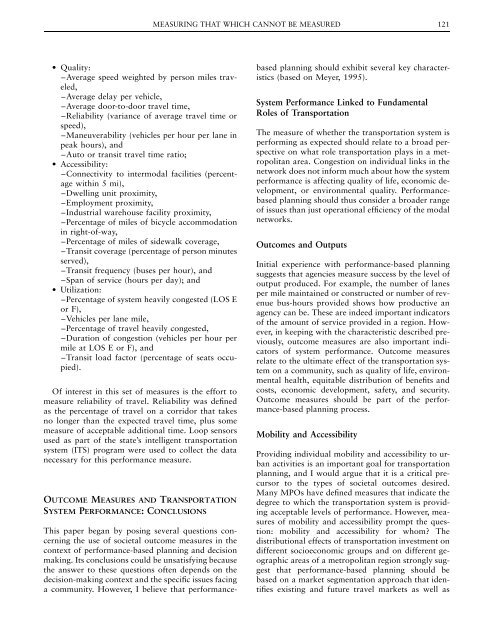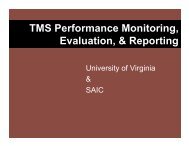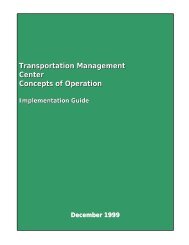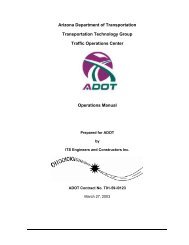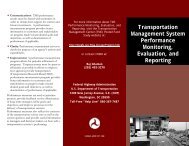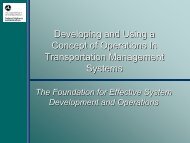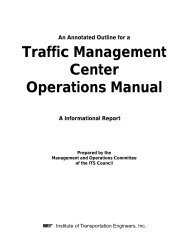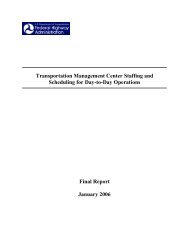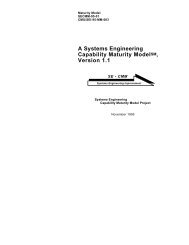120 PERFORMANCE MEASURES TO IMPROVE TRANSPORTATION SYSTEMS AND AGENCY OPERATIONS–Percentage of disadvantaged travelers with publictransportation alternatives for essential businessand personal travel.Given the national focus of this agency, it is not surprisingthat these measures are defined at a muchbroader scale than those discussed in the previouscases. The use of a survey for determining the role oftransportation in economic productivity is of interest.Minnesota DOT’s Business PlanningPerformance TargetsThe Minnesota DOT has been one of the nation’sleaders in developing performance measures targetedat the business of the agency. In the mid-1990s, MinnesotaDOT developed the concept of a ‘‘family ofmeasures’’ that reflected the range of impacts andoutcomes that are influenced by transportation systemperformance. These outcomes and example measuresinclude the following from Minnesota DOT in1998:• Time directness: A predictable travel time forlength of trip is maintained so that customer expectationsare met.–Number of freeway miles congested,–Average travel time and distance, and–Percentage of Minnesotans satisfied with triptime.• Safety: Incidents and crash rates are minimizedto Minnesota DOT’s current and potential ability toinfluence infrastructure, partnerships and education,full range of solutions, and driver behavior.–Motor vehicle crash rates and fatal crashes byroadway design,–Percentage of Minnesotans feeling safe whiledriving in work zones, and–Percentage of Minnesotans satisfied with thesafety of roadways.• Condition of infrastructure: An infrastructurethat meets customer expectations is maintained.–Pavement quality index,–Bridge structural rating, and–Bridge functional rating.• Access and basic levels of service: Services areprovided to meet personal travel and shipping needs.–Percentage of Minnesotans with satisfactorytransit options,–Posted bridges and bridge load carryingcapacity,–Miles of truck highway spring weight restrictions,and–Percentage of Minnesotans satisfied with travelinformation.• Environment: Minnesota DOT is a proactive, responsible,environmental steward.–Percentage of residential areas in incorporatedareas exposed to noise that exceeds standards,and–Number of wetland acres affected and replacedby Minnesota DOT.• Socioeconomics: <strong>Transportation</strong> investmentsyield the highest possible economic return to the region,tempered by an evaluation of community valuesand social impacts.–Total vehicle miles traveled and freight tonmiles,–Maintenance and construction expendituresper vehicle mile traveled, and–Percentage of highway funds going to construction.Additional measures have been proposed for inclusionin this family of measures, including the state’stransportation investment and spending as a percentageof the state’s gross state product and shipmentcost per mile by ton or value, mode, and majorcommodity.Senior management adopted target values formany of these system performance measures that relateto departmental strategic objectives. For example,a strategic objective that relates to the economichealth of the state could be to ensure that corridorsof statewide significance link the state’s regional tradecenters (measured by the miles of major highwaysbetween cities attaining a threshold average speed).Florida DOT’s Mobility MeasureFlorida DOT (2000) focused on ‘‘mobility’’ as the keysystem performance measure for ‘‘supporting investmentdecisions and policy analysis.’’ Mobility—defined as the ease with which people and goodsmove throughout the community, state, and world—is measured as the quantity of travel served, qualityof travel, accessibility, and use of transportation systems.Some example measures for each include thefollowing:• Quantity:–Person miles traveled,–Truck miles traveled,–Person trips, and–Ridership;
MEASURING THAT WHICH CANNOT BE MEASURED 121• Quality:–Average speed weighted by person miles traveled,–Average delay per vehicle,–Average door-to-door travel time,–Reliability (variance of average travel time orspeed),–Maneuverability (vehicles per hour per lane inpeak hours), and–Auto or transit travel time ratio;• Accessibility:–Connectivity to intermodal facilities (percentagewithin 5 mi),–Dwelling unit proximity,–Employment proximity,–Industrial warehouse facility proximity,–Percentage of miles of bicycle accommodationin right-of-way,–Percentage of miles of sidewalk coverage,–Transit coverage (percentage of person minutesserved),–Transit frequency (buses per hour), and–Span of service (hours per day); and• Utilization:–Percentage of system heavily congested (LOS Eor F),–Vehicles per lane mile,–Percentage of travel heavily congested,–Duration of congestion (vehicles per hour permile at LOS E or F), and–Transit load factor (percentage of seats occupied).Of interest in this set of measures is the effort tomeasure reliability of travel. Reliability was definedas the percentage of travel on a corridor that takesno longer than the expected travel time, plus somemeasure of acceptable additional time. Loop sensorsused as part of the state’s intelligent transportationsystem (ITS) program were used to collect the datanecessary for this performance measure.OUTCOME MEASURES AND TRANSPORTATIONSYSTEM PERFORMANCE: CONCLUSIONSThis paper began by posing several questions concerningthe use of societal outcome measures in thecontext of performance-based planning and decisionmaking. Its conclusions could be unsatisfying becausethe answer to these questions often depends on thedecision-making context and the specific issues facinga community. However, I believe that performancebasedplanning should exhibit several key characteristics(based on Meyer, 1995).System Performance Linked to FundamentalRoles of <strong>Transportation</strong>The measure of whether the transportation system isperforming as expected should relate to a broad perspectiveon what role transportation plays in a metropolitanarea. Congestion on individual links in thenetwork does not inform much about how the systemperformance is affecting quality of life, economic development,or environmental quality. Performancebasedplanning should thus consider a broader rangeof issues than just operational efficiency of the modalnetworks.Outcomes and OutputsInitial experience with performance-based planningsuggests that agencies measure success by the level ofoutput produced. For example, the number of lanesper mile maintained or constructed or number of revenuebus-hours provided shows how productive anagency can be. These are indeed important indicatorsof the amount of service provided in a region. However,in keeping with the characteristic described previously,outcome measures are also important indicatorsof system performance. Outcome measuresrelate to the ultimate effect of the transportation systemon a community, such as quality of life, environmentalhealth, equitable distribution of benefits andcosts, economic development, safety, and security.Outcome measures should be part of the performance-basedplanning process.Mobility and AccessibilityProviding individual mobility and accessibility to urbanactivities is an important goal for transportationplanning, and I would argue that it is a critical precursorto the types of societal outcomes desired.Many MPOs have defined measures that indicate thedegree to which the transportation system is providingacceptable levels of performance. However, measuresof mobility and accessibility prompt the question:mobility and accessibility for whom? Thedistributional effects of transportation investment ondifferent socioeconomic groups and on different geographicareas of a metropolitan region strongly suggestthat performance-based planning should bebased on a market segmentation approach that identifiesexisting and future travel markets as well as
- Page 5 and 6:
National Academy of SciencesNationa
- Page 7 and 8:
Workshop Summary ..................
- Page 9:
General OverviewIntroductionExecuti
- Page 12 and 13:
4 PERFORMANCE MEASURES TO IMPROVE T
- Page 14 and 15:
6 PERFORMANCE MEASURES TO IMPROVE T
- Page 18 and 19:
10 PERFORMANCE MEASURES TO IMPROVE
- Page 20 and 21:
12 PERFORMANCE MEASURES TO IMPROVE
- Page 23:
Linking Performance Measures withDe
- Page 26 and 27:
18 PERFORMANCE MEASURES TO IMPROVE
- Page 28 and 29:
20 PERFORMANCE MEASURES TO IMPROVE
- Page 30 and 31:
22 PERFORMANCE MEASURES TO IMPROVE
- Page 32 and 33:
24 PERFORMANCE MEASURES TO IMPROVE
- Page 34 and 35:
26 PERFORMANCE MEASURES TO IMPROVE
- Page 36 and 37:
28 PERFORMANCE MEASURES TO IMPROVE
- Page 38 and 39:
30 PERFORMANCE MEASURES TO IMPROVE
- Page 40 and 41:
32 PERFORMANCE MEASURES TO IMPROVE
- Page 42 and 43:
Panel DiscussionJohn Poorman, Capit
- Page 44 and 45:
36 PERFORMANCE MEASURES TO IMPROVE
- Page 46 and 47:
38 PERFORMANCE MEASURES TO IMPROVE
- Page 48 and 49:
Workshop SummaryJohn Basilica, Loui
- Page 50 and 51:
42 PERFORMANCE MEASURES TO IMPROVE
- Page 52 and 53:
44 PERFORMANCE MEASURES TO IMPROVE
- Page 55 and 56:
RESOURCE PAPERImplementing Performa
- Page 57 and 58:
IMPLEMENTING PERFORMANCE MEASUREMEN
- Page 59 and 60:
IMPLEMENTING PERFORMANCE MEASUREMEN
- Page 61 and 62:
IMPLEMENTING PERFORMANCE MEASUREMEN
- Page 63 and 64:
IMPLEMENTING PERFORMANCE MEASUREMEN
- Page 65 and 66:
IMPLEMENTING PERFORMANCE MEASUREMEN
- Page 67 and 68:
Panel DiscussionJennifer Finch, Col
- Page 69 and 70:
FIGURE 2Level of measures and align
- Page 71 and 72:
PANEL DISCUSSION: AGENCY IMPLEMENTA
- Page 73 and 74:
PANEL DISCUSSION: AGENCY IMPLEMENTA
- Page 75 and 76:
PANEL DISCUSSION: AGENCY IMPLEMENTA
- Page 77 and 78: PANEL DISCUSSION: AGENCY IMPLEMENTA
- Page 79 and 80: WORKSHOP SUMMARY: AGENCY IMPLEMENTA
- Page 81: Selecting Measures, Data Needs, and
- Page 84 and 85: 76 PERFORMANCE MEASURES TO IMPROVE
- Page 86 and 87: 78 PERFORMANCE MEASURES TO IMPROVE
- Page 88 and 89: 80 PERFORMANCE MEASURES TO IMPROVE
- Page 90 and 91: 82 PERFORMANCE MEASURES TO IMPROVE
- Page 92 and 93: 84 PERFORMANCE MEASURES TO IMPROVE
- Page 94 and 95: 86 PERFORMANCE MEASURES TO IMPROVE
- Page 96 and 97: Panel Discussion, Part 1Anita Vande
- Page 98 and 99: 90 PERFORMANCE MEASURES TO IMPROVE
- Page 100 and 101: 92 PERFORMANCE MEASURES TO IMPROVE
- Page 102 and 103: Panel Discussion, Part 2Douglas Zim
- Page 104 and 105: FIGURE 11 Example data
- Page 106 and 107: 98 PERFORMANCE MEASURES TO IMPROVE
- Page 108 and 109: Workshop SummaryBrenda Berg, Trans
- Page 110 and 111: 102 PERFORMANCE MEASURES TO IMPROVE
- Page 113 and 114: RESOURCE PAPERMeasuring That Which
- Page 115 and 116: MEASURING THAT WHICH CANNOT BE MEAS
- Page 117 and 118: TABLE 1Sustainability MeasuresNewma
- Page 119 and 120: MEASURING THAT WHICH CANNOT BE MEAS
- Page 121 and 122: MEASURING THAT WHICH CANNOT BE MEAS
- Page 123 and 124: MEASURING THAT WHICH CANNOT BE MEAS
- Page 125 and 126: MEASURING THAT WHICH CANNOT BE MEAS
- Page 127: MEASURING THAT WHICH CANNOT BE MEAS
- Page 131 and 132: MEASURING THAT WHICH CANNOT BE MEAS
- Page 133 and 134: MEASURING THAT WHICH CANNOT BE MEAS
- Page 135 and 136: PANEL DISCUSSION: CONNECTING SYSTEM
- Page 137 and 138: PANEL DISCUSSION: CONNECTING SYSTEM
- Page 139 and 140: PANEL DISCUSSION: CONNECTING SYSTEM
- Page 141 and 142: PANEL DISCUSSION: CONNECTING SYSTEM
- Page 143 and 144: Workshop SummaryScott Bassett, Oreg
- Page 145: Freight Performance MeasuresCurrent
- Page 148 and 149: 140 PERFORMANCE MEASURES TO IMPROVE
- Page 150 and 151: 142 PERFORMANCE MEASURES TO IMPROVE
- Page 152 and 153: 144 PERFORMANCE MEASURES TO IMPROVE
- Page 154 and 155: 146 PERFORMANCE MEASURES TO IMPROVE
- Page 156 and 157: 148 PERFORMANCE MEASURES TO IMPROVE
- Page 158 and 159: 150 PERFORMANCE MEASURES TO IMPROVE
- Page 160 and 161: 152 PERFORMANCE MEASURES TO IMPROVE
- Page 163 and 164: APPENDIX ASummaries of 20 Poster Se
- Page 165 and 166: SUMMARIES OF 20 POSTER SESSIONS 157
- Page 167 and 168: TABLE 1(continued) WSDOT Outcomes,
- Page 169 and 170: SUMMARIES OF 20 POSTER SESSIONS 161
- Page 171 and 172: SUMMARIES OF 20 POSTER SESSIONS 163
- Page 173 and 174: SUMMARIES OF 20 POSTER SESSIONS 165
- Page 175 and 176: SUMMARIES OF 20 POSTER SESSIONS 167
- Page 177 and 178: FIGURE 2 Sacramento Regional Transi
- Page 179 and 180:
FIGURE 3Goal evaluation table: Chit
- Page 181 and 182:
SUMMARIES OF 20 POSTER SESSIONS 173
- Page 183 and 184:
SUMMARIES OF 20 POSTER SESSIONS 175
- Page 185 and 186:
SUMMARIES OF 20 POSTER SESSIONS 177
- Page 187 and 188:
TABLE 6Mobility Performance Measure
- Page 189 and 190:
SUMMARIES OF 20 POSTER SESSIONS 181
- Page 191 and 192:
SUMMARIES OF 20 POSTER SESSIONS 183
- Page 193 and 194:
SUMMARIES OF 20 POSTER SESSIONS 185
- Page 195 and 196:
FIGURE 13 MPAH lane-miles by roadwa
- Page 197 and 198:
SUMMARIES OF 20 POSTER SESSIONS 189
- Page 199 and 200:
SUMMARIES OF 20 POSTER SESSIONS 191
- Page 201 and 202:
SUMMARIES OF 20 POSTER SESSIONS 193
- Page 203 and 204:
SUMMARIES OF 20 POSTER SESSIONS 195
- Page 205 and 206:
SUMMARIES OF 20 POSTER SESSIONS 197
- Page 207 and 208:
SUMMARY OF PEER EXCHANGE ON DATA FO
- Page 209 and 210:
SUMMARY OF PEER EXCHANGE ON DATA FO
- Page 211 and 212:
SUMMARY OF PEER EXCHANGE ON DATA FO
- Page 213 and 214:
SUMMARY OF PEER EXCHANGE ON DATA FO
- Page 215 and 216:
SUMMARY OF PEER EXCHANGE ON DATA FO
- Page 217 and 218:
SUMMARY OF PEER EXCHANGE ON DATA FO
- Page 219 and 220:
SUMMARY OF PEER EXCHANGE ON DATA FO
- Page 221 and 222:
SUMMARY OF PEER EXCHANGE ON DATA FO
- Page 223 and 224:
APPENDIX C: RESEARCH STATEMENTS DEV
- Page 225 and 226:
LIST OF PARTICIPANTS 217University,
- Page 227:
LIST OF PARTICIPANTS 219Darwin Stua


